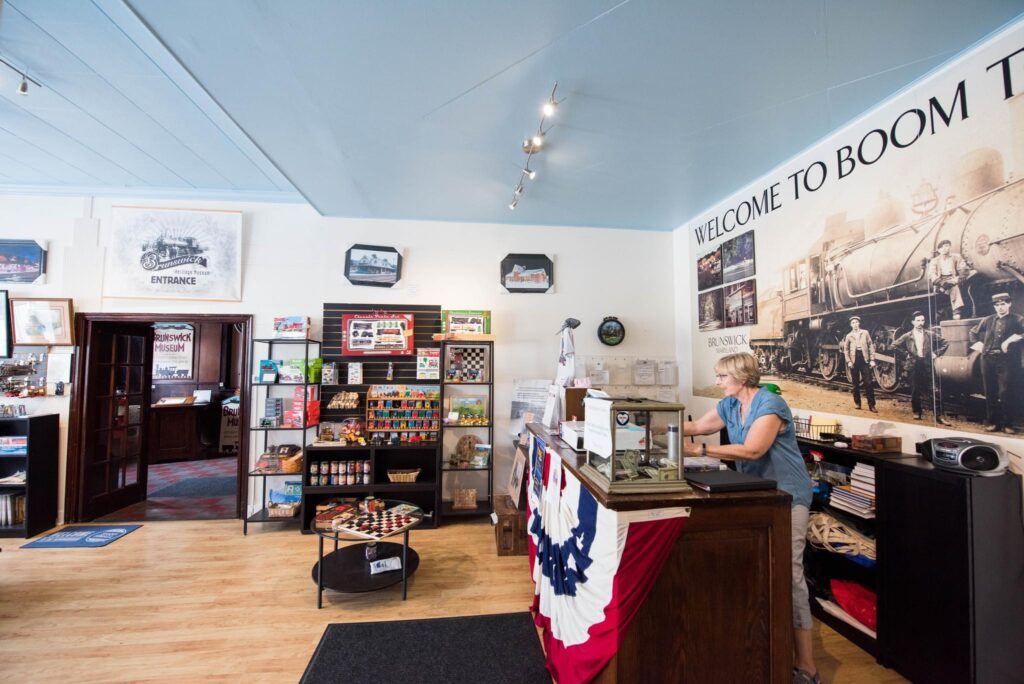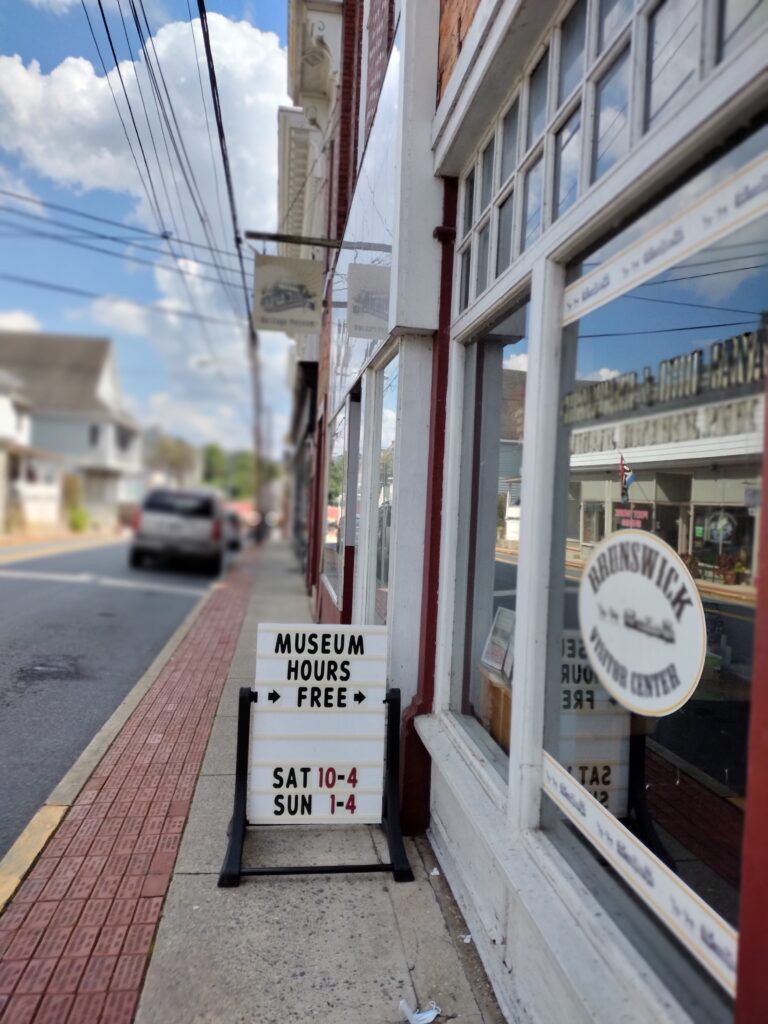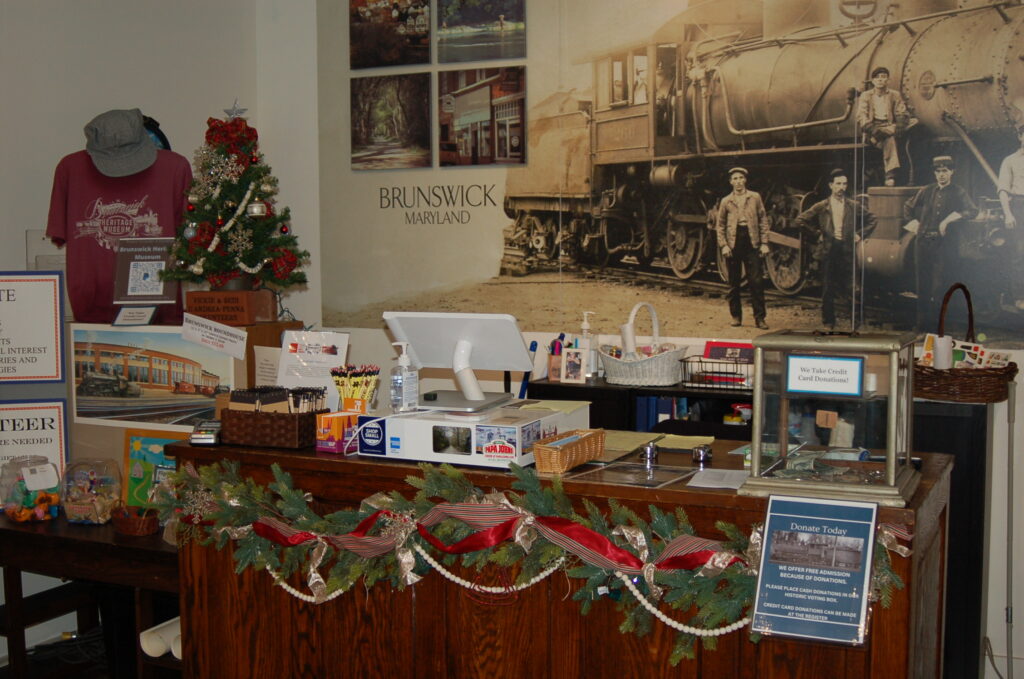Brunswick is the quintessential home for a heritage museum. The small southwestern Frederick city’s dual identities — as a railroad town and canal town — show up in the Brunswick Heritage Museum’s collection of exhibits that preserve, celebrate and share the city’s unique history and culture.
The museum, located just off the C&O Canal towpath at mile 55, gives area residents as well as visitors opportunities to appreciate and understand Brunswick’s past as well as its place in the future.

The museum’s foremost steward of Brunswick history is James Castle, who lives in Brunswick with his wife, Monica, and their four cats.
“I have lived in the greater Brunswick area for most of my life. My family has been in the area since the 1770s,” he said.
Now 46, he began studying local history at a “very young age … My free time found me digging local dump sites, looking for arrowheads along creek beds, talking to area seniors, and reading books at the library.”
At age 20, Castle began volunteering at the museum, initially in the gift shop, and not long after, as a board member.
“I have worked in every aspect of the museum, and am now the board president,” he said. “My professional life is dedicated to assisting folks recover from disasters, but all of my free time is spent preserving local history.”
As the leading source on Brunswick history, Castle penned a three-volume book series, “History in Our Attics: Photos and Documents of Brunswick, MD,” published from 2014 to 2018, and a short story, “A Christmas Trip to Brunswick,” published in 2016.


As a founding member of the Brunswick Main Street organization, a nonprofit “that seeks to create and sustain a vibrant downtown for all to enjoy,” Castle inhabits the persona of “Brakeman Jim,” leading historical walking tours of the city and telling tales of paranormal events at the museum.
Located less than a block from the Brunswick Line MARC commuter line and four tracks of the CSX mainline, the museum is housed in the former Improved Order of Red Men fraternal lodge, a three-story brick building built in 1904. When the Fraternal Order of Eagles Brunswick Aerie No. 1136 bought the building on June 1, 1936, the Native American statue at the entrance was removed; it now stands on the museum’s second floor.
Reflecting Brunswick’s history as a Baltimore & Ohio Railroad company town, the museum was founded in 1974 as the Brunswick Railroad Museum, when the board of directors purchased the building for $30,000, according to Castle.
“The mortgage was paid off by soliciting $1 donations and selling baked goods,” he said.
It originally focused exclusively on railroads, but in 2013, the name was changed to Brunswick Heritage Museum, and its mission expanded to “tell the stories of Brunswick, past to present, through dynamic presentations and programs for history lovers and rail fans of all ages.”

The three-story building slowly filled with artifacts, and a model train club began building a layout on the third floor, Castle said.
“Now, 50 years later, the building is filled with Brunswick’s history, and the model layout is a massive draw for rail fans in the area,” he added.
The Brunswick Potomac Foundation, Inc., operates the museum, with an annual budget of about $75,000, Castle said, funded mostly by donations and with assistance from the city.
Admission to the museum “is absolutely free, but we do appreciate donations,” he added.
The foundation’s board, elected from the organization’s membership, welcomes members and the public to its meetings, typically at 7 p.m. on the third Monday of each month. Interested parties should verify time and date by emailing contact@brunswickmuseum.org.
“The museum is 100% run by volunteers,” Castle noted. “Not one of our 25 volunteers receives pay. We have board members, museum store volunteers, model train operators, and a curatorial committee.”
Visitors will find exhibits that interpret life in the city.
The first floor is home to the C&O Canal National Historical Park-Brunswick Visitor Center and The City of Brunswick Visitor Center, where photographs and interactive elements illustrate the canal’s history from its 1828 groundbreaking to 1971 when the land became a national historical park.

On the second floor, exhibits portray how Brunswick residents lived and worked through the years. There’s a painting of African Americans in Brunswick working in the railroad freight yards by Carl Butler, whose grandfather was the first Black firefighter in Brunswick.
Photographs of Brunswick show how the city has change, including images depicting the train yard that became a commuter parking lot, and a bank that is now the town hall. For baseball aficionados, Brunswick Railroad Little League statistics from 1986 are posted next to modern photographs of the Brunswick team playing in the Little League World Series.
Before the building became a museum, the third floor was a dance hall for the Lions Club, where country music artist Patsy Cline performed in the 1960s. Now the whole room is occupied by the HO scale model railroad layout that “depicts the B&O’s Metropolitan branch from Washington’s Union Station to Harpers Ferry, West Virginia, as it looked in the 1950s/1960s,” Castle said. It was an accurate representation until the 1980s when most of the trains moved to Cumberland.
The Brunswick classification yard, whose 5 miles were completed in 1907, constitutes the biggest part of the layout; at the time, it was the country’s largest and most modern yard to serve a single railroad company, Castle noted. The “people” on the layout are modeling activities such as fixing a roof, extinguishing a fire, going to the fair, and kayaking. Many interactive elements were added in 2007.
Like so many public institutions, the museum shut down during the COVID-19 pandemic, and so, an e-museum was created at https://brunswickmuseum.org. It features the video series, “Brunswick History 101,” with 17 episodes on various subjects including “Geology,” “Native Americans,” and “The B&O RR and C&O Canal Arrive,” as well as a photo archive of artifacts found at the museum.

Castle hopes to expand upon the virtual museum in the future, and is in the process of posting thousands of images from the museum’s collection that have not been seen by the public to the website.
“Next year is the 50th anniversary of the museum, and we have big plans,” Castle said.
The first is a $500,000 façade restoration project, and later in the year, an anniversary fundraising banquet to honor the museum’s five decades.
The Brunswick Heritage Museum, 40 W. Potomac St., is open on Saturday, 10 a.m. to 4 p.m., and Sunday, 1 to 4 p.m.
After checking out the museum’s gems, visitors can stop at the first-floor shop for Brunswick-related gifts such as T-shirts, mugs, ornaments, postcards, magnets, toys, books and household items, Castle said.
By Ellyn Wexler
